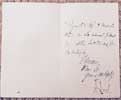A letter handwritten & signed by Soyer.
to an unidentified correspondent, detailing two items in a catalogue of paintings [not present].
2 pages. 8vo. Full cream coloured sheet 228 x 182 mm. Folded 115 x 182 mm. A full sheet folded in half with a slight split at the bottom of the fold. It is in a very clear and legible condition. Dated Nov. 23rd 1857. Soyer writes “Dear Sir I beg to send herewith a calogue of my paintings you will find the Two sent you marked Nos…. & … In centre, or rather between the two you might insert “Youth & Age” & describe them in the usual place viz. At the bottom as per catalogue – I remain Dear Sir Yours faithfully A Soyer.“ Housed in a very fine handmade slip case with a label on the front cover.
- The Wikipedia entry for Emma [Jones] Soyer is worth repeating here, to help put the letter in a context. To quote -- The daughter of a Mr. Jones who died in 1818, she was born in London in 1813, and was carefully instructed in French, Italian, and music. At a very early age she became a pupil of F. Simoneau the painter, who in 1820 married her mother, Mrs. Jones. Finding that Emma had talents for drawing, Simoneau ultimately devoted the whole of his time to her instruction, and before the age of twelve she had drawn more than a hundred portraits from life with surprising fidelity. On 12 April 1837 she married Alexis Soyer the cook. She now turned her attention to portraits in oil, and, with her master, traveled in the provinces and gained great popularity. Upon her return to London she produced 'The Blind Boy,' 'The Crossing Sweeper,' 'The Bavarians,' 'Taglioni and the Kentish Ceres.' In 1842 she completed her last work, 'The Two Organ Boys.' She also showed two paintings at the 1842 Paris Salon ('L'aveugle de la tour de Londres' and 'Portrait de M. Soyer' - Nos. 1729-30). Her portrait famous of Soyer was also engraved by Henry Bryan Hall. On 29–30 Aug. 1842 she had complications with her pregnancy, owing to fright produced by a terrible thunderstorm, and she died the same night at her residence near Charing Cross, London. She was buried at Kensal Green Cemetery, London on 8 September, where her husband erected a sumptuous monument to her memory. Between 1823 and 1843 fourteen of her pictures were exhibited at the Royal Academy, thirty-eight at the British Institution, and fourteen at the Suffolk Street Gallery (Graves, Dictionary of Artists, pp. 130, 221). In June 1848 one hundred and forty of her works were exhibited at the Prince of Wales's bazaar, under the name of Soyer's Philanthropic Gallery, on behalf of the Spitalfields soup kitchen, and a catalogue was printed. Among these pictures was 'The Young Savoyards Resting,' a work that obtained for Madame Soyer the name of the 'English Murillo.' Two of her paintings - 'The Jew Lemon Boys' and 'The English Ceres,' were engraved by Gérard. In Paris, where many of her pictures were exhibited, her reputation stood higher than in her native country - unquote. The paintings to which Alexis Benoist Soyer (4 February 1810 – 5 August 1858) refers to, are most likely those created by his late wife. This letter is written less than 9 months before his death and fifteen years after Emma’s. He must have inherited all of her artistic output and possibly had a catalogue printed to sell them. Indications are that Soyer was not careful with money. This makes sense as he left only £1500 at his death. A rum distiller called David Hart succeeded in taking all the cash and Soyer's personal papers in lieu of an unpaid debt. He destroyed all the papers and notes. Because of that short-sighted and selfish action, any signed or manuscript notes in Soyer's hand are extremely rare. Only rare letters like this one here, owned by a third party are likely to come onto market.




click on image to enlarge

Ephemera category
ref number:
11234